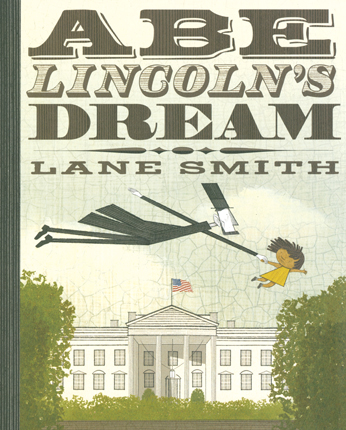Full Text Reviews: Booklist - 09/15/2012 In Smith’s latest presidential-themed offering, the Lincoln Room at the White House is haunted. The proof? Over the years, none of the presidential pets would step paw inside. Enter an inquisitive girl named Quincy (homage to Adams?) who is taking a school tour of the White House and spots the ghost of Lincoln standing over the Gettysburg Address. Quincy and Lincoln tell silly jokes and share what they most often dream about—for Lincoln, he is on a ship sailing toward an unknown shore. Eventually, Quincy leads Lincoln out of the White House and gives him an update on progress since 1865; the former prez is happy to know the states are united. While there are plenty of juicy historical tidbits for teachers and librarians to mine here, kids may need help to follow the random musings and sort fact from fiction. The excellent, textured artwork mixes period and modern details well, and the beige palette, with hints of red and blue, is lovely. A perhaps too-brief afterword references the dream, which haunted Lincoln the morning of his assassination, and notes the “presidential pooches.” HIGH-DEMAND BACKSTORY: Highly acclaimed Smith is just coming off his Caldecott Honor win for Grandpa Green (2011). Teachers, librarians, and anyone who knows anything about kids’ books will be anticipating this one. - Copyright 2012 Booklist. School Library Journal - 12/01/2012 Gr 2–5—A picture book that transforms the 16th president from a seemingly austere, severe figure into a sympathetic character. A young African American girl named Quincy encounters the ghost of Abe Lincoln on a school tour of the White House. He tells the child about a recurring dream in which he is sailing a ship on a stormy sea, unsure of where he's heading. (The afterword explains that the president reported having this nightmare several times, including the evening before his assassination.) In an attempt to cheer him, Quincy reassures Lincoln that the state of the nation has vastly improved since his presidency, and the two take flight on a whirlwind tour. Dynamic spreads of the Statue of Liberty, Mount Rushmore, and an American flag planted on the Moon-digitally rendered in oil painting and pen-and-ink-reflect Quincy's assertion that "'overall the founding fathers would be proud of our progress.'" The dark palette and parchmentlike background give the book a traditional feel, but Smith adds a sense of whimsy through his creative use of fonts and the witty tone of the narrative. Despite the cartoonish style, Lincoln is fully humanized: visible pen marks that indicate wrinkles and bags under his eyes suggest his anguish over the state of the union, while his penchant for corny jokes ("'Ghosts are no good at telling fibs….You can see right through them'") will endear him to readers. Pair this picture book with Maira Kalman's Looking at Lincoln (Penguin, 2012) to give students a portrait of the man that transcends mere facts.—Mahnaz Dar, School Library Journal - Copyright 2012 Publishers Weekly, Library Journal and/or School Library Journal used with permission. Bulletin for the Center... - 01/01/2013 Quincy, a young African-American girl, has wandered off from her school group while touring the White House. If that in itself isn’t enough to signal a fantasy, then meeting up with the ghost of the sixteenth president surely is. Lincoln’s penchant for corny wordplay and his soft spot for children are evident as he engages with Quincy in an exchange of goofy jokes, but the child readily senses the gloom and unease that trouble her otherwise gracious host, and the root of his depression is worry over the current state of the Union. Quincy is able to reassure Lincoln that the states have remained united, and equality for all is “getting better all the time.” As to whether man continues to “fuss ’n’ fight with his fellow man,” Quincy has to admit, “We’re still working on that,” as a chair and broken glass erupt from the side of the U.S. Capitol. That’s reassuring enough to put the wandering soul to rest, and to shift the president’s persistent dream of a ship heading toward an unknown shore to that of a boat traveling toward the rising sun. A host of antique-style fonts and the dominant sepia, black, and red colors of the illustrations suggest printing of bygone days, but the lanky angularity and funky surrealism of the figures moving through the haunted White House and out into space are more akin to a Tim Burton creation. Two brief notes comment on Lincoln’s recurring dream and the White House dogs that avoided the “haunted” Lincoln Bedroom, but children unequipped with prior knowledge of the causes of the president’s depression won’t find much enlightenment here. The picture-book set will be better served by Maira Kalman’s equally imaginative approach in Looking at Lincoln BCCB 1/11), but this may be of passing interest to well-informed youngsters. EB - Copyright 2013 The Board of Trustees of the University of Illinois. Loading...
|



